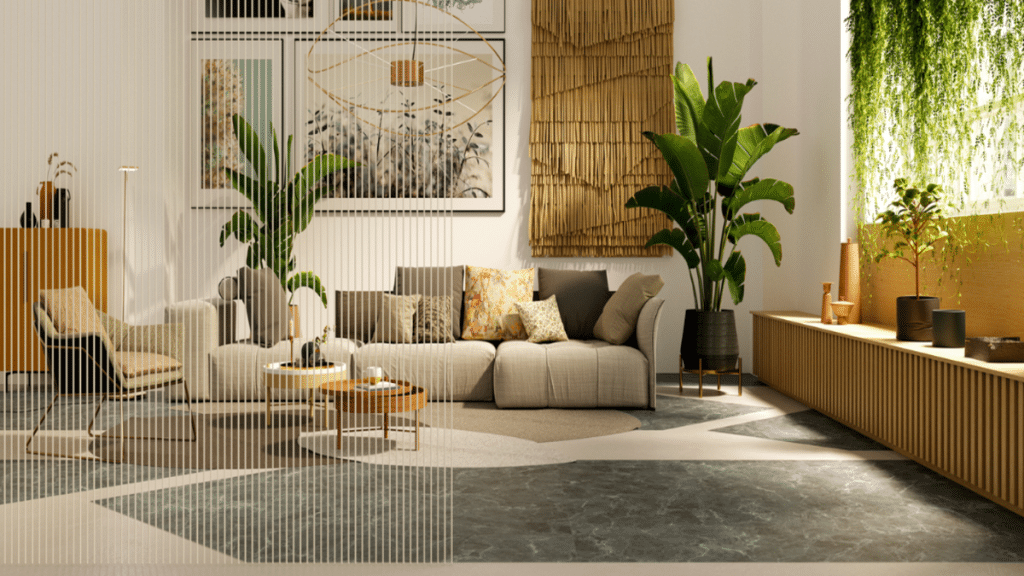Across the UAE, interior design is evolving, and one of the most compelling shifts is toward biophilic design—an approach that reconnects built environments with nature. As rapid urban development continues, designers in Dubai and Abu Dhabi are seeking ways to bring calm, well-being, and sensory harmony into homes, offices, and public spaces.
Biophilic Design Gains Momentum in the UAE
Biophilic design has gone from niche to mainstream in the region. Major projects across Abu Dhabi and Dubai are integrating natural materials like stone, wood, and clay, along with living walls and indoor gardens. In luxury residential settings, including Palm Jumeirah villas and downtown penthouses, the city’s elite are adopting elements like vertical gardens and water features to create opulent yet soothing environments.
Research notes that in the UAE, where the view from a window often includes other buildings or the desert, designers are layering biophilic cues—textures, lighting patterns, and symbolic natural references—to foster a connection with the outdoors. There’s also growing demand for wellness-focused interiors that prioritize emotional comfort, not just visual appeal.
Core Elements of Biophilic Interiors
Natural Light Optimization
Expansive windows, skylights, and glass facades are essential to a biophilic space. In the UAE’s intense climate, designers use high-performance glazing and smart tinting systems to let in light without overheating interiors. Daylight becomes a design tool—not just for visibility, but for regulating mood and energy.
Green Walls and Indoor Gardens
Advanced vertical gardens and green walls are appearing in private homes, luxury hotels, and even retail stores. These installations go beyond aesthetics; they absorb sound, purify the air, and act as living sculptures. Many are equipped with self-watering systems and climate controls, making them sustainable and low-maintenance.
Organic Materials and Local References
Materials like reclaimed wood, limestone, woven rattan, and unpolished marble are chosen not just for their natural origins but for how they age and evolve over time. Many UAE-based designers are also incorporating textures inspired by sand dunes, desert flora, and Arabic calligraphy to blend biophilic ideals with regional identity.
Water Features and Relaxing Acoustics
From indoor fountains to subtle wall-mounted water sheets, the sound and movement of water calms the senses. It’s also being paired with acoustic design—using moss panels, cork surfaces, and wood grids—to reduce echo and mimic the hush of nature.
Airflow and Movement
Biophilic interiors embrace gentle air currents, often using layout and architecture to create cross-ventilation. In upscale projects, ceiling fans are being replaced with whisper-quiet airflow systems that replicate the feeling of a breeze—soft, cooling, and ever-shifting.
Technology Meets Nature
The newest frontier in biophilic design is the integration of smart systems. These include:
- AI-powered climate controls that adjust light and temperature based on the time of day and outdoor conditions.
- Smart gardens that monitor plant health and water levels.
- Circadian lighting systems that change color temperature to match the natural rhythm of sunrise and sunset.
Rather than viewing technology and nature as opposites, today’s design leaders see them as complementary forces. In the UAE, where extreme heat often limits outdoor activity, this harmony is particularly valuable.
A New Standard in Wellness Design
One of the strongest reasons for biophilic design’s success in the UAE is its impact on wellness. In a region where indoor lifestyles dominate due to climate, it’s more important than ever to design spaces that support human biology and psychology.
Benefits include:
- Improved mood and reduced stress levels
- Greater cognitive focus in workspaces
- Better sleep and relaxation at home
- Enhanced indoor air quality
- Increased property value in premium real estate markets
These benefits have captured the attention of developers, especially in Dubai’s competitive real estate scene. Projects now promote biophilic features as a core value proposition—not just a design choice.
When to Consult Local Expertise
If you’re planning a project in the UAE—whether a villa in Jumeirah, a business lounge in DIFC, or a spa in Al Ain—you’ll want a team that understands both global design trends and local conditions. Consulting an interior design company in Dubai with deep experience in biophilic principles will ensure your space is not just beautiful, but also biologically responsive and culturally appropriate.
These companies can advise on native plant species, desert-adapted materials, light behavior in Gulf climates, and the latest in smart eco-technologies tailored to the region.
Biophilic Design in Hospitality, Retail, and Education
This approach is also changing commercial sectors. In hotels, biophilic design is used to create a sense of escape—lush courtyards, shaded walkways, and scent-driven lobbies. In retail, it increases dwell time and shopper comfort. In schools and universities, nature-inspired environments reduce anxiety and improve student performance.
The versatility of biophilic design allows it to scale, juwhether it’s a boutique salon or a sprawling wellness resort.
Looking Ahead
Biophilic design in the UAE isn’t just a passing trend—it’s becoming a cornerstone of sustainable, wellness-oriented architecture. As 2025 progresses, expect to see deeper integration: AI-guided light cycles, adaptive materials, sensory “garden rooms,” and multi-sensory interiors that adjust to their users.
Design is moving beyond surfaces. It’s becoming living, responsive, and emotionally intelligent.
Final Reflection
Biophilic design in the UAE isn’t ornamental—it’s intentional. By weaving nature into the urban fabric—through light, materials, greenery, water, and airflow—designers are shaping a new era of well-being. In a region known for its futuristic ambition, perhaps the boldest move is to look back to nature, and bring it forward—into every room, hallway, and home.
